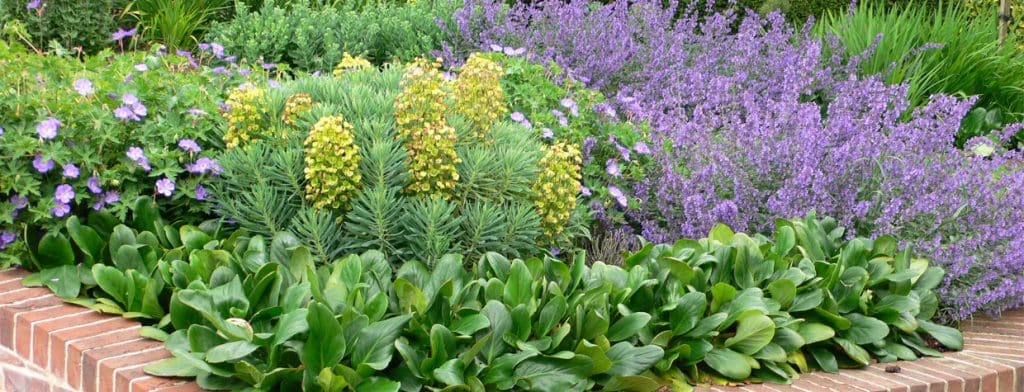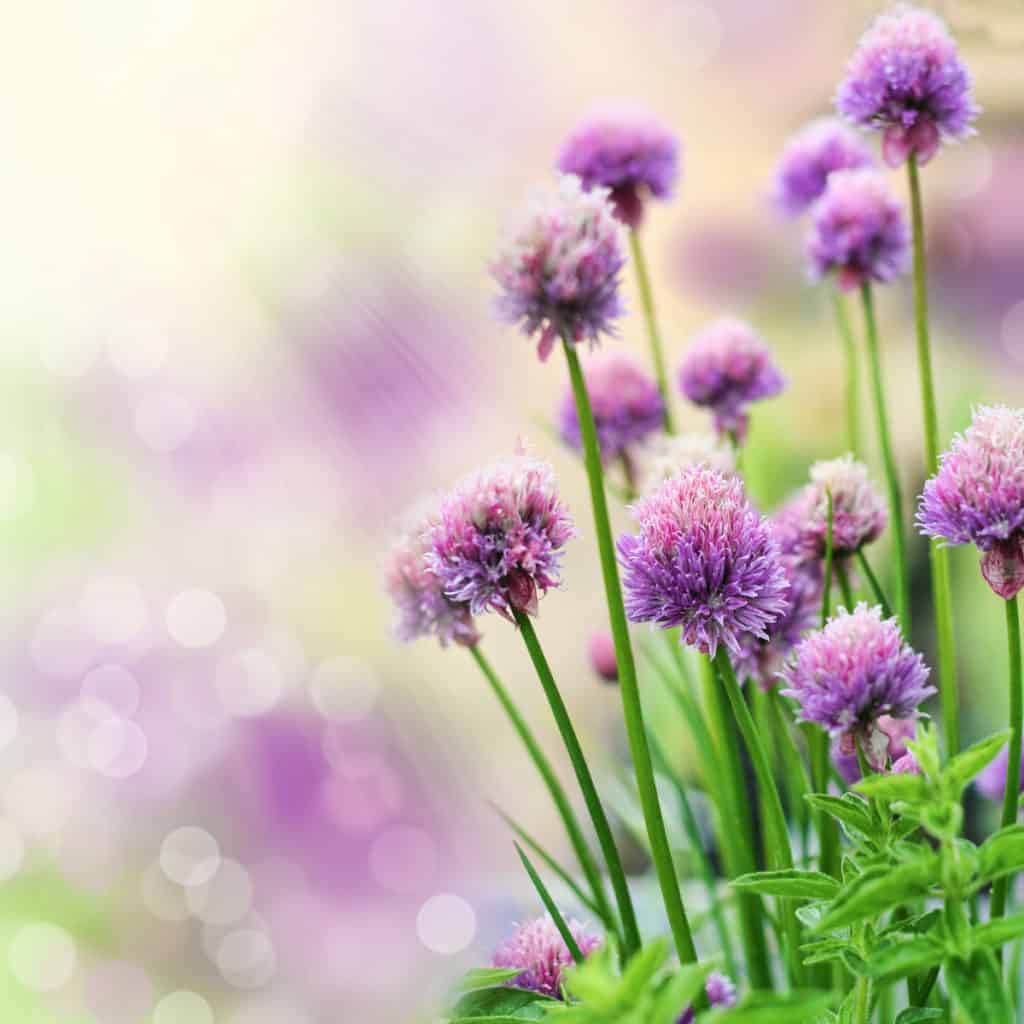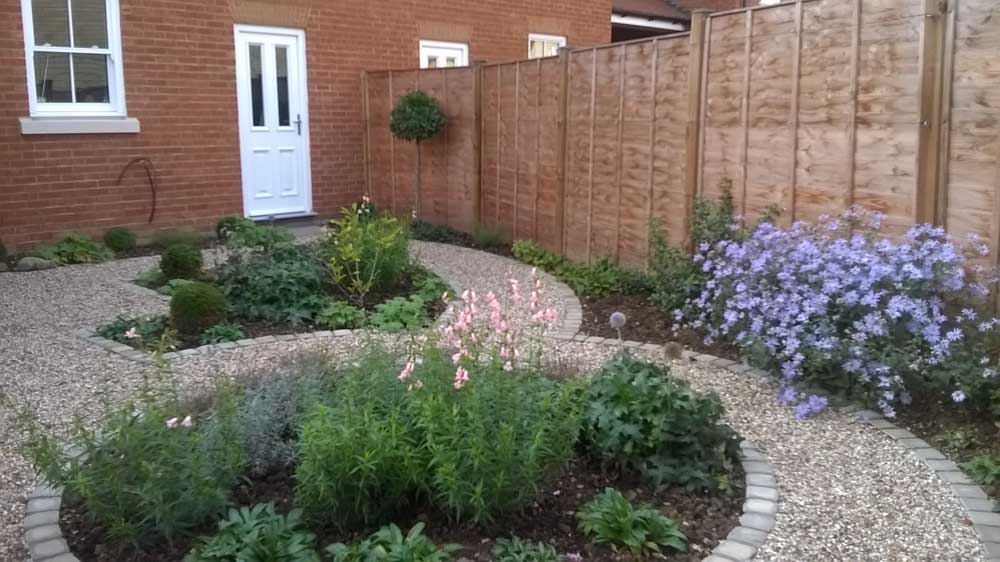16 Jul Designing drought tolerant gardens
As a garden designer, it’s important to me that my planting schemes are robust and long lasting. This summer is showing us all why it’s important to design drought tolerant gardens.
Most of my garden design clients, and indeed clients of the landscapers that I work with, ask for a low maintenance garden. That means careful plant choices. Using perennials that don’t need to be replaced year on year, finding plants that won’t outgrow their position too fast and also looking for species that are resistant to pests and diseases. As well, of course, as looking amazing all year round. Being drought tolerant is becoming more and more of a requirement too.
Beth Chatto is one of my all-time favourite garden designers and plants women. Along with her husband, Andrew, Beth harnessed the knowledge that a happy plant is a low maintenance plant. Over the course of 50 years, she created some marvellous gardens based on her learning and experience. I’m fortunate enough to live quite near to her gardens in Colchester and it’s somewhere I like to visit for inspiration. Sadly Beth passed away earlier this year but her garden is as strong as ever and opens to the public most days.
Using horticultural knowledge for drought tolerant gardens
Gardeners want to get the best from their plants. They want the biggest possible tomatoes, the brightest flowers and the greenest lawns. In Britain we’ve spent the last 3 or more centuries inventing things to make that happen. Fertilisers, greenhouses, growing medium, pesticides – the list goes on. As our climate changes, so do the challenges for gardeners and garden designers. Strong horticultural knowledge will help us to make the right choices and adapt garden design so that we can:
- Create the ideal conditions for plants to grow
- Choose plants that are drought tolerant, mild mannered and therefore easy to maintain
- Use plant combinations to the best possible effect
- Use drought-busting management techniques such as mulching and irrigation
This planting scheme uses drought tolerant plants that are also frost hardy in winter. Dense plant coverage helps to shade the soil and reduce the amount of water lost to evaporation on hot sunny days.
Manipulating the microclimate for drought tolerant outdoor spaces
Some clients already know what plants they’d like to see in their garden. They might want an area for growing vegetables, a lush natural lawn, the climbing roses that remind them of someone special or cottage garden plants to attract bees. Topiary, hedges, herbs and wild flowers are also particularly fashionable at the moment. Then there are the clients who have colour preferences but don’t mind which species we use. Blues and purples are popular colours as are golds and greens.
My job as a garden designer is to create a space within their garden where their favourite plants will thrive. Every plant species has its own unique set of requirements for light, temperature, humidity, soil type, ventilation, water and sometimes stakes and supports. That goes for trees and lawns as well as for herbaceous plants.
If budget allows it, we can change and improve the soil, open up vistas, play with drainage to create ideal conditions. We can contour the land to provide shelter from drying winds, and encourage water retention in some areas. We can create raised planting areas, add irrigation systems, and even divert grey water from your bath and washing machine to use to water your plants. But in general, choosing the right plants from the very outset will make for manageable drought tolerant gardens.
Choosing plants that are drought tolerant
Visiting gardens like Beth Chatto’s is a great way to study plants and their growing conditions. And it’s surprising how many plant species and varieties are drought tolerant. (Of course we also need to factor in things like shade, winter hardiness, maintenance needs etc.)
Cacti are not the only drought tolerant plants. These chives thrive in well drained soils with plenty of sunshine. The flowers are a magnet for bees and to top it all – the leaves taste great in a potato salad.
If government predictions are correct we’re going to have hotter, drier summers and milder, wetter winters. Temperature wise, that’s drawing me towards the Mediterranean type plants. Herbs, such as sage, thyme, rosemary and lavender will happily bask in warm, well drained soils AND they are pollinator friendly.
Looking around the gardens and in the countryside at the moment I can see that the plants that are doing well in this drought are the ones with long fleshy roots, fine leaves, and large waxy leaves, are growing in the shade of buildings and hedges and/or are succulent plants. For now I’m ignoring the ones that have benefitted from irrigation – we’ll talk about that later.
Natural lawns are a good indicator of drought. They turn from lush green to crispy brown almost overnight. That’s not a problem for the plants and I personally don’t mind too much but if a brown lawn isn’t to your taste, why not replace the lawn with a different garden design feature? The curves, contours and colours in thispathway mean it looks good all year round.
Designing a drought tolerant garden
Irrigation
The obvious way to combat drought is to irrigate. However, the population of Essex and Suffolk is rising. The more people that live here, the more demand there is for clean water and, realistically, should we find ourselves facing regular droughts, water companies will give priority to supplying water for health and hygiene – rather than for lawns and flowers. Hosepipe bans are possible, and indeed likely. That makes irrigation a challenge and drought tolerant gardens essential.
Including automated irrigation systems where possible – especially for planters, vegetable plots, conservatories and greenhouses. You may not be allowed to use them if there’s a hosepipe ban but leaky pipe type irrigation is more efficient and less costly to run than a hosepipe. Plus you can operate it from your phone if you happen to be away from home. Some systems allow you to use grey water (from your bath, shower, washing machine etc.) to irrigate your plants. This will be a great help if we have a hosepipe ban. Personally I think they should be compulsory for new build houses – but that’s another blog altogether.
Soil types
Improving the soil by adding more organic matter to retain moisture without compromising winter drainage.
Mulching around trees and plants will help enormously too. You can use shredded bark or compost, or there are some really attractive aggregate mulches available nowadays. I like these pebbles that we used around a wildlife pond. Varying the sizes makes them look natural – rather like a dry river bed.
Plant choices
Choosing plants that can cope with everything the British weather is likely to offer. Dense planting shades the ground keeping the roots cool and reducing water loss through evaporation.
Thinking hard about whether a natural lawn is appropriate – perhaps a gravel garden would be better or a prairie type planting that is spectacular to look at and easy to care for, or even a drought tolerant sedum lawn? Not as hardwearing as grass but still rather beautiful.
This sea holly or eryngium is a beautifully architectural plant that’s loved by bees, butterflies and garden designers. One variety is called “Miss Willmotts Ghost” seemingly because a nineteenth century gardener called Ellen Willmott used to scatter seeds in gardens she was visiting. Months later the plants would appear as a reminder that the lady had been there.
Caring for wildlife
Wildlife isn’t everybody’s first consideration when it comes to garden design. But you can be sure if you are suffering the effects of drought, so will everything else in the ecosystem that supports you.
You can help by incorporating little garden design ideas, like using pollinator friendly plants and having a source of water for birds and insects.
This buff tailed bumble bee is enjoying her visit to the flowers on an oregano plant. Oregano is a low growing mediterranean herb that grows happily in this country – even when the soil is dry. And yes – it is the oregano that you can cook with. It’s especially good in spaghetti bolognesese.
Microclimate
Use fencing, screens and hedges as wind breaks – fast moving air is notorious for drying out gardens.
Protecting your own garden against drought
Right now, my garden is looking sorry for itself. The lawn is brown, the dahlias are floppy and some of my perennial plants are at death’s door. However, some things look good. The lavenders, sedums and acanthus are thriving in these conditions, as are the hollyhocks, the Icelandic poppies and the Eryngium.
A complete redesign or rebuild is out of the question right now but I can (and will) change the planting this autumn to include more drought tolerant plants and hopefully have a more attractive garden next year.
If you are in a similar frame of mind, but don’t know what to plant, I can happily create a planting plan for you.
Choose from our range of garden design packages, or better still, call us for an informal chat with one of our garden designers and we can build a bespoke package just for you.
Find out about our bespoke planting plans
Re-planting your garden this year? Think ahead and plan for all seasons – especially spring. More in this article










Sorry, the comment form is closed at this time.